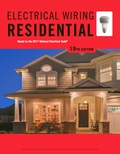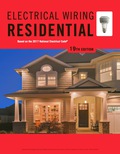
EBK ELECTRICAL WIRING RESIDENTIAL
19th Edition
ISBN: 9781337516549
Author: Simmons
Publisher: CENGAGE LEARNING - CONSIGNMENT
expand_more
expand_more
format_list_bulleted
Concept explainers
Question
Chapter 2.1, Problem 16R
To determine
Explain the reason for representing lines in curved shape in problem 4.
Expert Solution & Answer
Trending nowThis is a popular solution!

Students have asked these similar questions
P 4.4-22 Determine the values of the node voltages V1, V2, and
v3 for the circuit shown in Figure P 4.4-22.
202
ww
4ia
202
w
+
+
±12 V
V₁
ΖΩ
V2
ΖΩ
V3
11 A
+
하
3. An inifinite sheet of charge density of 3 nC/m² is located at x=-1m. An infinite line of charge
density 1 nC/m is parallel to the the z-axis and intersect the y-axis at y=-1m. (a) What is the
electric field vector at (0, 0, 0), assuming & = ε0? (b) What is the region in space
where the field is zero?
Find the valve of voltage Vx using SUPERPOSITION
1 M
FA
www
4
5
M
MAA
12V
-
$10
33
M
23
+x
mn
6
8A
Chapter 2 Solutions
EBK ELECTRICAL WIRING RESIDENTIAL
Ch. 2.1 - What is the purpose of specifications?Ch. 2.1 - Refer to the specifications in the back of this...Ch. 2.1 - What is done to prevent a plan from becoming...Ch. 2.1 - Name three requirements contained in the...Ch. 2.1 - Prob. 5RCh. 2.1 - What phrase is used when a substitution is...Ch. 2.1 - What is the purpose of an electrical symbol?...Ch. 2.1 - Prob. 8RCh. 2.1 - Prob. 9RCh. 2.1 - What three parties must be satisfied with the...
Ch. 2.1 - What does a plan show about electrical outlets?...Ch. 2.1 - Prob. 13RCh. 2.1 - Prob. 14RCh. 2.1 - Prob. 15RCh. 2.1 - Prob. 16RCh. 2.1 - Prob. 17RCh. 2.1 - Prob. 18RCh. 2.1 - Prob. 19RCh. 2.1 - What methods may be used to mount luminaries to an...Ch. 2.1 - What advantage does a 4 in. octagon box have over...Ch. 2.1 - What is the size of the opening of a switch...Ch. 2.1 - Prob. 23RCh. 2.1 - Prob. 24RCh. 2.1 - Prob. 25RCh. 2.1 - Prob. 26RCh. 2.1 - Prob. 27RCh. 2.1 - Prob. 28RCh. 2.1 - Prob. 29RCh. 2.1 - Prob. 30RCh. 2.1 - Prob. 31RCh. 2.1 - Prob. 32RCh. 2.1 - Prob. 33RCh. 2.1 - Prob. 35RCh. 2.1 - Prob. 37RCh. 2.1 - Prob. 38RCh. 2.1 - Prob. 39RCh. 2.1 - Prob. 40RCh. 2.1 - Prob. 42RCh. 2.1 - Does the NEC allow metal raceways to be used with...Ch. 2.2 - Prob. 1RCh. 2.2 - What is the size of the footing for the steel...Ch. 2.2 - Prob. 3RCh. 2.2 - Prob. 4RCh. 2.2 - Prob. 5RCh. 2.2 - Prob. 6RCh. 2.2 - How far is the front garage wall from the curb?...Ch. 2.2 - How far is the side garage wall from the property...Ch. 2.2 - Prob. 9RCh. 2.2 - What is the purpose of the I-beams that rest on...Ch. 2.2 - Where is access to the attic provided?...Ch. 2.2 - Prob. 13RCh. 2.2 - Prob. 14RCh. 2.2 - Prob. 15RCh. 2.2 - Prob. 16RCh. 2.2 - What is the stud size for the partitions between...Ch. 2.2 - Who is to furnish the range hood?...Ch. 2.2 - Who is to install the range hood?...
Knowledge Booster
Learn more about
Need a deep-dive on the concept behind this application? Look no further. Learn more about this topic, electrical-engineering and related others by exploring similar questions and additional content below.Similar questions
- Find the Valve of Voltage Vy using SUPERPOSITION الله 8 ZV ДАДА 6 5 ча 4 w 3 1 mm 2A MWarrow_forwardFind the value of voltage Using SUPER POSITION. GV www 6 M 33 ww ЧА 5. 123 AM 4 4 ۱۹۷arrow_forwardPlease explain in detail. I am most confused on how to get the transfer functions. thank youarrow_forward
- Please explain step by step in detail. I am most confused about the table. Thank youarrow_forwardUsing the block diagram or solution, show that the expected gain in the transfer function CA' (s)/Q'(s) is negative. Please explain how to approach this. No typed answers where the equation is in one line and it's hard to understand, please дома dela 1 C_AO G2(s) G3(5) dCA(t) dt dT' (t) dt = 2 Q beta 3-a G1(s) G4(s) (-AHko E koe RT + EKOČA RT2 E e E F T' (t) + Co (t) E 1 (All) (- -)+(y) = pcp eRT CA(t) + Е КОСАДНЕ PCPRT2 eRT T'(t) + Q'(t) 2 Tarrow_forwardplease explain in detail. I am most confused about 3.2 and 3.3. thank youarrow_forward
arrow_back_ios
SEE MORE QUESTIONS
arrow_forward_ios
Recommended textbooks for you
 EBK ELECTRICAL WIRING RESIDENTIALElectrical EngineeringISBN:9781337516549Author:SimmonsPublisher:CENGAGE LEARNING - CONSIGNMENT
EBK ELECTRICAL WIRING RESIDENTIALElectrical EngineeringISBN:9781337516549Author:SimmonsPublisher:CENGAGE LEARNING - CONSIGNMENT

EBK ELECTRICAL WIRING RESIDENTIAL
Electrical Engineering
ISBN:9781337516549
Author:Simmons
Publisher:CENGAGE LEARNING - CONSIGNMENT